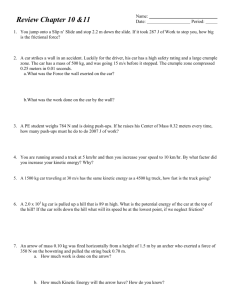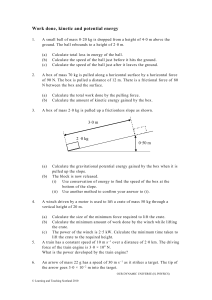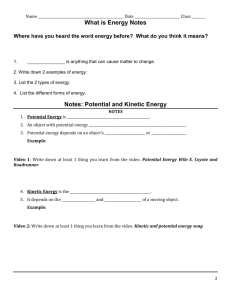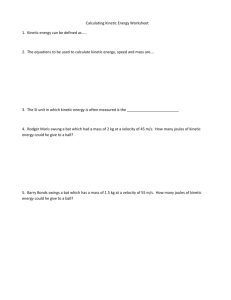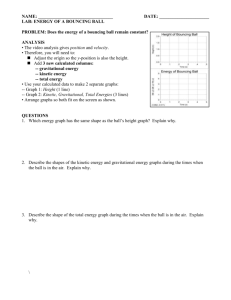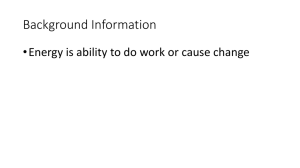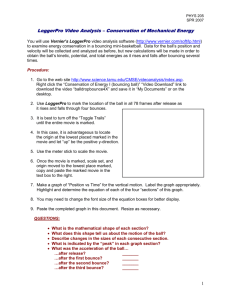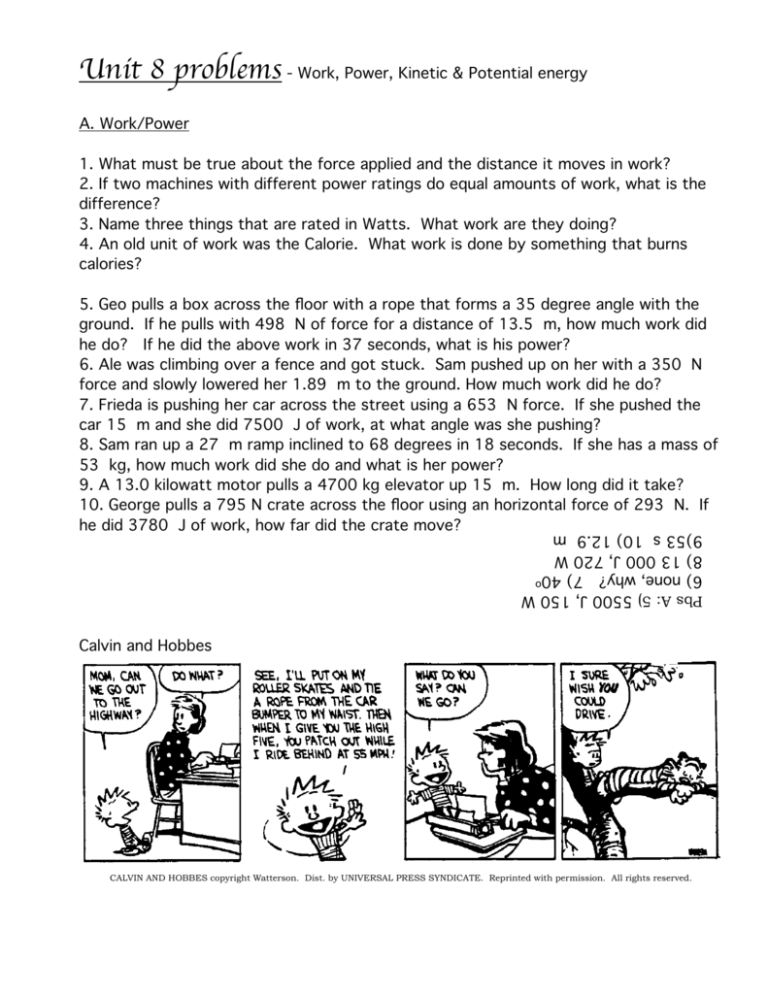
Unit 8 problems - Work, Power, Kinetic & Potential energy
A. Work/Power
1. What must be true about the force applied and the distance it moves in work?
2. If two machines with different power ratings do equal amounts of work, what is the
difference?
3. Name three things that are rated in Watts. What work are they doing?
4. An old unit of work was the Calorie. What work is done by something that burns
calories?
5. Geo pulls a box across the floor with a rope that forms a 35 degree angle with the
ground. If he pulls with 498 N of force for a distance of 13.5 m, how much work did
he do? If he did the above work in 37 seconds, what is his power?
6. Ale was climbing over a fence and got stuck. Sam pushed up on her with a 350 N
force and slowly lowered her 1.89 m to the ground. How much work did he do?
7. Frieda is pushing her car across the street using a 653 N force. If she pushed the
car 15 m and she did 7500 J of work, at what angle was she pushing?
8. Sam ran up a 27 m ramp inclined to 68 degrees in 18 seconds. If she has a mass of
53 kg, how much work did she do and what is her power?
9. A 13.0 kilowatt motor pulls a 4700 kg elevator up 15 m. How long did it take?
10. George pulls a 795 N crate across the floor using an horizontal force of 293 N. If
he did 3780 J of work, how far did the crate move?
Pbs A: 5) 5500 J, 150 W
6) none, why? 7) 40o
8) 13 000 J, 720 W
9)53 s 10) 12.9 m
Calvin and Hobbes
"
CALVIN AND HOBBES copyright Watterson. Dist. by UNIVERSAL PRESS SYNDICATE. Reprinted with permission. All rights reserved.
B. Kinetic and Potential Energy
1. To change the total amount of Kinetic and Potential energy in a system, what must
be done to that system?
2. Most potential energy can be changed into kinetic energy. What other forms of
energy can it be transformed into?
3. Name three types of Potential Energy. When we talk about it in this class, which
type are we referring to?
4. As the earth moves through its elliptical orbit around the sun, it is closer to the sun
during our winter. At that time it is also moving faster. Explain in terms of energy.
5. Moises drops a ball from a height of 8 meters. If the ball does not bounce, what
type of collision is it? What happened to the energy? If the ball does bounce, what
type of collision is it? Will the ball bounce back up to 8 meters? Why/why not?
6. A major source of electricity in many parts of the world is hydroelectric dam power.
How do dams get energy? How do we get energy from dams?
7. If a rock is thrown upwards with an initial velocity of 32.8 m/s, how high will it go?
8. A 1500 kg car moving at 47.3 m/s has the same kinetic energy as a 4500 kg truck.
What is the speed of the truck? Do they have equal momentums?
9. Luis shoots a .10 kg arrow horizontally from a height of 1.5 m. If he pulled back
with 298 N and pulled the arrow back .65 m before releasing, how fast is the arrow
going when it leaves the bow? How far does it go before hitting the ground?
10. Joe slides down a rough slide that is 3.8 m long and forms a 43.2 degree angle
with the ground. If his mass is 47.3 kg and his speed at the bottom of the slide is
6.38 m/s, what percentage of his potential energy was converted to heat?
11. Connor starts from rest and rides a roller coaster down a 35.8 m hill and then up a
28.7 m hill. How fast is she moving when she hits the top of that second hill?
Pbs B: 7) 54.8 m
8) 27 m/s, no
9) 62 m/s, 34 m
10) 20%
11) 11.8 m/s


